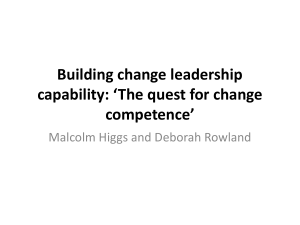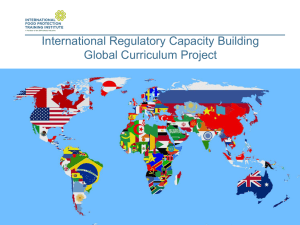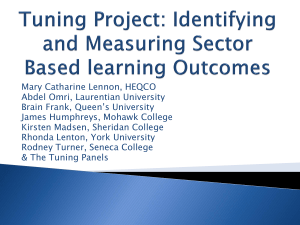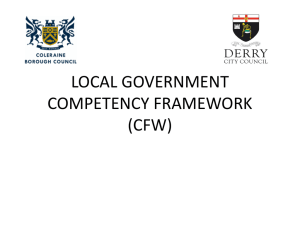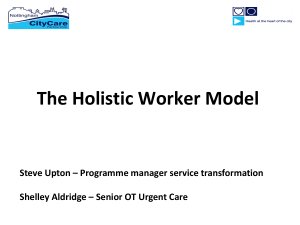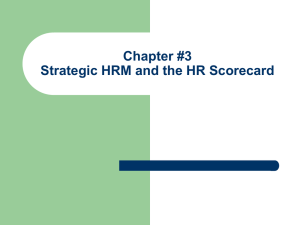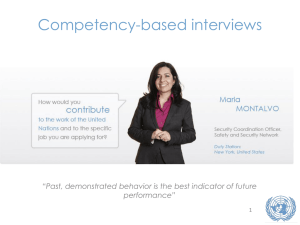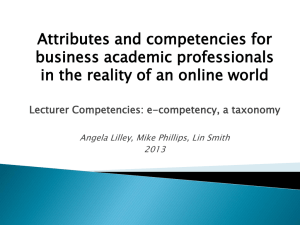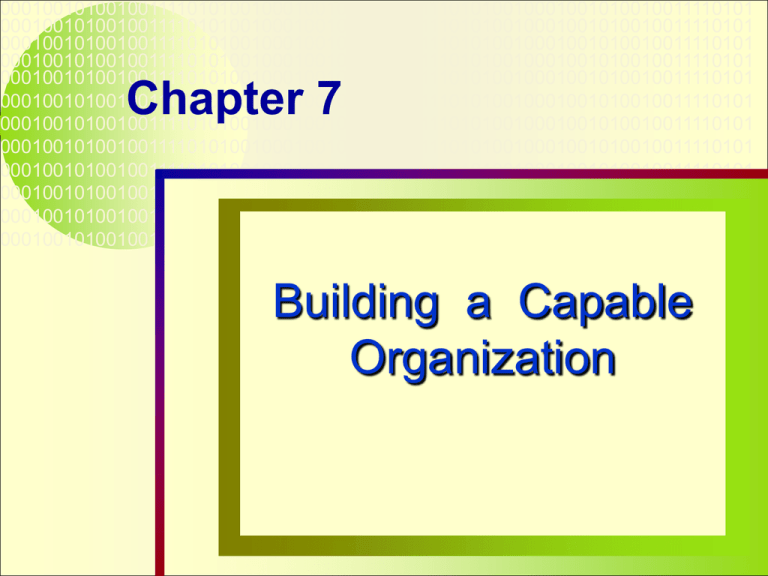
000100101001001111010100100010010100100111101010010001001010010011110101
000100101001001111010100100010010100100111101010010001001010010011110101
000100101001001111010100100010010100100111101010010001001010010011110101
000100101001001111010100100010010100100111101010010001001010010011110101
000100101001001111010100100010010100100111101010010001001010010011110101
000100101001001111010100100010010100100111101010010001001010010011110101
000100101001001111010100100010010100100111101010010001001010010011110101
000100101001001111010100100010010100100111101010010001001010010011110101
000100101001001111010100100010010100100111101010010001001010010011110101
000100101001001111010100100010010100100111101010010001001010010011110101
000100101001001111010100100010010100100111101010010001001010010011110101
000100101001001111010100100010010100100111101010010001001010010011110101
Chapter 7
Building a Capable
Organization
1
7-1
“The best game plan in the
world never blocked or
tackled anybody.”
Vince Lombardi
“Strategies most often fail
because they aren’t
executed well.”
Larry Bossidy
Chapter Outline
A Framework for Executing Strategy
The Principal Managerial Components of the
Strategy Execution Process
Building a Capable Organization
Staffing the Organization
Building Core Competencies and Competitive
Capabilities
Matching Organization Structure to Strategy
Organizational Structures of the Future
3
7-3
Crafting vs. Executing the Strategy
Crafting the Strategy
Primarily a market-driven
Primarily an operations-
activity
Successful strategy
making depends on
driven activity
Successful strategy
execution depends on
Business vision
Good organization-
Perceptive analysis of the
building and people
management
Creating a strategysupportive culture
Continuous improvement
Getting things done and
delivering good results
situation
Attracting and pleasing
customers
Outcompeting rivals
Forging a competitive
advantage
4
Executing the Strategy
7-4
Executing the Strategy
An action-oriented, make-things happen
task involving management’s ability to
Direct organizational change
Achieve continuous improvement in
Implementation
involves . . .
operations and business processes
Create and nurture a
strategy-supportive culture
Consistently meet or beat performance targets
Tougher and more time-consuming
than crafting strategy
5
7-5
Why Executing Strategy Is a
Tough Management Job
Demanding variety of managerial
6
activities to be performed
Numerous ways to tackle each activity
Requires good people management skills
Requires launching and managing
a variety of initiatives simultaneously
Number of bedeviling issues to be worked out
Battling resistance to change
Hard to integrate efforts of many different work
groups into a smoothly-functioning whole
7-6
Implementing a Newly Chosen
Strategy Requires Adept Leadership
Implementing a new strategy
takes adept leadership to
Convincingly communicate
reasons for the new strategy
Overcome pockets of doubt
Build consensus and enthusiasm
Secure commitment of concerned parties
Get all implementation pieces in place and
coordinated
7
7-7
Who Are the
Strategy Implementers?
Implementing and executing strategy involves a
company’s whole management team and all of its
employees
Just as every part of a watch plays a role in making the
watch function properly, it takes all pieces of an
organization working cohesively for a strategy
to be well-executed
Top-level managers must lead the
process and orchestrate major initiatives
But they must rely on the cooperation of middle
and lower-level managers to see that things go well in the
various parts of the organization and on employees to
perform their roles competently on a daily basis
8
7-8
What Are the Goals of the Strategy
Implementing-Executing Process?
Unite total organization behind strategy
See that activities are done in a manner that is
conducive to first-rate strategy execution
Generate commitment so an enthusiastic
crusade emerges to carry out strategy
Fit how organization
conducts its operations
to requirements of
strategy
9
7-9
Characteristics of the Strategy
Implementation Process
Every manager has an active role
No 10-step checklists
Few concrete guidelines
Least charted, most open-ended
part of strategic management
Cuts across many aspects of “how to
manage”
10
7 - 10
Characteristics of the Strategy
Implementation Process (continued)
Each implementation situation occurs in
a different context, affected by differing
Business practices and competitive situations
Work environments and cultures
Policies
Compensation incentives
Mix of personalities and firm histories
Approach to implementation
has be customized to fit the situation
People implement strategies - Not companies!
11
7 - 11
Fig. 7.1: The Eight Actions of
Implementing and Executing Strategy
12
7 - 12
Action Agenda of Top Executives in
Leading the Implementation Process
Communicating the case for change
Building consensus on how to proceed
Installing strong allies in areas where they can push
implementation along in key business units
Empowering subordinates to keep process moving
Establishing measures of progress and deadlines
Rewarding those who achieve
implementation milestones
Directing resources to the right places
Personally leading the strategic change process
13
7 - 13
BUILDING A CAPABLE
ORGANIZATION—WHAT IS
INVOLVED?
McGraw-Hill/Irwin
© 2003 The McGraw-Hill Companies, Inc., All Rights Reserved.
14
Fig. 7.2: The Three Components of
Building a Capable Organization
15
7 - 15
Putting Together a Strong
Management Team
Assembling a capable management team is a
cornerstone of the organization-building task
Find the right people to fill each slot
Existing management team
may be suitable
Core executive group
may need strengthening
Promote from within
Bring in skilled outsiders
16
7 - 16
Selecting the Management Team:
Key Considerations
Determine mix of
Backgrounds
Experiences and know-how
Beliefs and values
Styles of managing and personalities
Personal chemistry must be right
Talent base needs to be appropriate
Picking a solid management team needs to be
acted on early in implementation process
17
7 - 17
Recruiting and Retaining Talented
Employees: Implementation Issues
Assemble needed human resources and
knowledge base for effective strategy execution
Biggest challenge facing high-tech companies
How to recruit and retain the best
and brightest talent with strong
skill sets and management potential
Intellectual capital, not tangible
assets, is increasingly being viewed
as the most important investment
Talented people are a prime source
of competitive advantage
18
7 - 18
Key Human Resource Practices to
Attract and Retain Talented Employees
Spend considerable effort in screening job
applicants, selecting only those with
Suitable skill sets
Energy and initiative
Judgment and aptitudes for learning
Ability to adapt to firm’s work
environment and culture
Put employees through training
programs throughout their careers
Give promising employees challenging,
interesting, and skill-stretching assignments
19
7 - 19
Key Human Resource Practices to Attract
and Retain Talented Employees (continued)
Rotate employees through jobs with great content,
spanning functional and geographic boundaries
Encourage employees to
Be creative and innovative
Challenge existing ways of
doing things and offer better ways
Submit ideas for new products or businesses
Foster a stimulating work environment
Exert efforts to retain high-potential employees with
excellent salary and benefits
Coach average employees to improve their skills
20
7 - 20
Building Core Competencies
and Competitive Capabilities
Crafting the strategy involves
Identifying the desired
competencies and capabilities
Good strategy execution requires
Putting desired competencies
and capabilities in place,
Upgrading them as needed, and
Modifying them as market conditions evolve
21
7 - 21
Strategically-Relevant Competencies
Greater proficiency in product development
Better manufacturing know-how
Capability to provide better after-sale service
Faster response to changing customer needs
Superior cost-cutting skills
Capacity to speed new products to market
Superior inventory management systems
Better marketing and merchandising skills
Specialized depth in unique technologies
Greater effectiveness in promoting union-
management cooperation
22
7 - 22
Example: Honda’s Core Competence
Expertise in gasoline engine
technology and small engine design
23
7 - 23
Example: Intel’s Core Competence
Design of complex chips for
personal computers
24
7 - 24
Example: Procter & Gamble’s
Core Competencies
Superb marketing-distribution skills and R&D
capabilities in five core technologies - fats, oils,
skin chemistry, surfactants, emulsifiers
25
7 - 25
Example: Sony’s Core Competence
Expertise in electronic technology and ability
to translate the expertise into innovative
products—miniaturized radios and video
cameras, TVs and VCRs with unique features,
attractively designed PCs
26
7 - 26
Three-Stage Process of Developing
Competencies and Capabilities
1. Develop ability to do something
2. As experience builds,
ability can translate into a
competence or capability
3. If ability continues to be polished and
refined, it can become a distinctive
competence, providing a potential
competitive advantage!
27
7 - 27
Step 1: Process of
Developing Competencies
Develop ability to do something
Select people with relevant skills/experience
Broaden or expand individual abilities as
needed
Mold efforts and work
products of individuals
into a cooperative effort to
create organizational ability
28
7 - 28
Step 2: Process of
Developing Competencies
As experience builds and company learns how
to perform the activity consistently well and at
acceptable cost, the ability evolves
into a competence or capability
Competencies emerge from establishing and
nurturing collaborative relationships between
Individuals and groups in departments and/or
A company and its external allies
29
7 - 29
Step 3: Process of
Developing Competencies
If company masters the activity, performing it
better than rivals, the “capability” becomes a
Distinctive competence and
Holds potential for
competitive advantage
This is the optimal outcome of the
capability-building process!
30
7 - 30
Managing the Process of Building
Competencies: Four Key Traits
1. Competencies are bundles of skills and knowhow growing from combined efforts of crossfunctional departments
2. Normally, competencies emerge incrementally
from various company efforts to respond to
market conditions
3. Leveraging competencies into competitive
advantage requires concentrating more effort
and talent than rivals on strengthening
competencies to create valuable capabilities
4. Sustaining competitive advantage requires
adjusting competencies to new conditions
31
7 - 31
Approaches to
Developing Competencies
Internal development involves either
Strengthening the company’s base of skills,
knowledge, and intellect or
Coordinating and networking the efforts of
various work groups and departments
Outsourcing by partnering with key suppliers
or forming strategic alliances
Buying a company that has the required
capabilities and integrating these
competencies into the firm’s value chain
32
7 - 32
Building Competencies:
Keys to Success
Selecting capable
employees
Training
Cultural influences and
peer pressures
Cooperation and
collaboration
33
Motivation
Empowerment
Attractive incentives
Organizational flexibility
Short deadlines
Good databases
7 - 33
Updating Competencies and
Capabilities as Conditions Change
Competencies and capabilities must
continuously be modified and perhaps
even replaced with new ones due to
New strategic requirements
Evolving market conditions
Changing customer expectations
Ongoing efforts to keep core competencies up-to-
date can provide a basis for sustaining both
Effective strategy execution and
Competitive advantage
34
7 - 34
Competitive Advantage Potential of
Competencies and Capabilities
When it is difficult to outstrategize
rivals with a superior strategy . . .
. . . Best avenue to industry
leadership is to outcompete rivals with
superior strategy execution!
Building competencies and capabilities
rivals can’t match is one of the
best ways to out-compete them!
35
7 - 35
Strategic Role of
Employee Training
Plays a critical role in implementation when a firm
shifts to a strategy requiring different
Skills-based competencies
Competitive capabilities
Managerial approaches
Operating methods
Types of training approaches
Internal “universities”
Orientation sessions for new employees
Tuition reimbursement programs
Online training courses
36
7 - 36
Matching Organization
Structure to Strategy
Few hard and fast rules for organizing
The One Big Rule: The role and purpose of the
organization structure is to support and
facilitate good strategy execution!
Each firm’s structure is idiosyncratic, reflecting
Prior arrangements and internal politics
Executive judgments and preferences about how to
arrange reporting relationships
How best to integrate and coordinate work effort of
different work groups and departments
CEO
Vice President
37
Vice President
Vice President
7 - 37
Fig. 7.3: Structuring the Work Effort to
Promote Successful Strategy Execution
38
7 - 38
Step 1: Decide Which Value Chain Activities
to Perform Internally and Which to Outsource
Involves deciding which activities are
essential to strategic success
Crucial business processes that must be
performed exceedingly well or in closely
coordinated fashion need to be
performed internally
Critical
Other activities, such as routine
activities
administrative housekeeping and
some support functions may be
candidates for outsourcing
39
7 - 39
Pinpointing Strategy-Critical Activities
1. What functions or business
processes have to be
performed extra well or in
timely fashion to achieve
competitive advantage?
2. In what value-chain activities
would poor execution seriously
impair strategic success?
40
7 - 40
Potential Advantages of
Outsourcing Non-Critical Activities
Decrease internal bureaucracies
Flatten organization structure
Speed decision-making
Provide firm with heightened strategic focus
Improve a firm’s innovative capacity
Increase competitive responsiveness
Outsourcing makes strategic sense when
outsiders can perform certain activities at a
lower cost and/or with higher value-added.
41
7 - 41
Appeal of Outsourcing
Outsourcing non-critical activities allows a firm
to concentrate its energies and resources on
those value-chain activities where it
Can create unique value
Can be best in the industry
Needs strategic control to
Build core competencies
Achieve competitive advantage
Manage key customer-supplier-distributor
relationships
42
7 - 42
Potential Advantages of Partnering
By building, improving, and then leveraging
partnerships, a firm enhances its overall
capabilities and builds resource strengths that
Deliver value to customers
Rivals can’t quite match
Consequently pave the way
for competitive success
Partnering makes strategic sense when the
result is to enhance organizational capabilities.
43
7 - 43
Dangers of Excessive Outsourcing
A company must guard against hollowing out
its knowledge base and capabilities
Guidelines to guard against excessive
outsourcing
Avoid sourcing key components from a single
supplier
Use two or three suppliers to minimize
dependence on any one supplier
Regularly evaluate suppliers
Work closely with key suppliers
44
7 - 44
Step 2: Make Strategy-Critical
Activities the Main Building Blocks
Assign managers of strategy-critical activities
a visible, influential position
Avoid fragmenting responsibility for strategy-
critical activities across many departments
Provide coordinating linkages
between related work groups
Meld into a valuable
competitive capability
45
Assign
managers
key roles
Primary
activities
Strategic
relationships
Support
functions
Coordination
Valuable
capability
7 - 45
Why Structure Follows Strategy
Changes in strategy typically require a new or
modified organization structure
A new strategy often involves different
skills, different key activities,
and different staffing and
organizational requirements
Hence, a new strategy signals
a need to reassess the
organization structure
How work is structured is a means to an end --
not an end in itself!
46
7 - 46
Guard Against Functional
Designs That Fragment Activities
Scattering pieces of critical business processes
across several specialized departments results in
Many hand-offs which
Lengthens completion time
Increases coordination and overhead costs
Increases risk of details falling
through the cracks
Obsession with activity rather than result
Solution Business process reengineering
Involves pulling strategy-critical processes
from functional silos to create process-complete
departments or cross-functional work groups
47
7 - 47
Examples of Fragmented StrategyCritical Activities
Filling customer orders
Speeding new products to market
Improving product quality
Supply chain management
Building capability to conduct business via the
Internet
Obtaining feedback from customers, making
product modifications to meet their needs
48
7 - 48
Step 3: Determine How Much
Authority to Delegate to Whom
In a centralized structure
Top managers retain authority for
most decisions
In a decentralized structure
Managers and employees are
empowered to make decisions
Trend in most companies
Shift from authoritarian to
decentralized structures
stressing empowerment
49
7 - 49
50
7 - 50
Maintaining Control in a
Decentralized Structure
Place limits on authority empowered
employees can exercise
Hold people accountable for their decisions
Institute compensation incentives that reward
employees for doing their jobs in a manner
contributing to good company performance
Create a corporate culture where
there’s strong peer pressure on
employees to act responsibly
51
7 - 51
Step 4: Provide for Internal
Cross-Unit Coordination
Classic method of coordinating activities -
Have related units report to single manager
Upper-level managers have clout to
coordinate/unify efforts of their units
Support activities should be
woven into structure in ways to
Maximize performance of primary activities
Contain costs of support activities
Formal reporting relationships often need
to be supplemented to facilitate coordination
52
7 - 52
Coordinating Mechanisms to Supplement
the Basic Organization Structure
Cross-functional task forces
Dual reporting relationships
Informal networking
Voluntary cooperation
Incentive compensation tied
to group performance
Teamwork and cross-
departmental cooperation
53
7 - 53
Step 5: Provide for
Collaboration With Outsiders
Need multiple ties at multiple levels to ensure
Communication
Coordination and control
Find ways to produce
collaborative efforts to enhance
firm’s capabilities and resource strengths
While collaborative relationships present
opportunities, nothing valuable is realized
until the relationship develops into an engine
for better organizational performance
54
7 - 54
Roles of Relationship Managers
With Strategic Partners
Get the right people together
Promote good rapport
See that plans for specific activities
are developed and implemented
Help adjust internal procedures
and communication systems to
Iron out operating dissimilarities
Nurture interpersonal ties
55
7 - 55
Perspectives on Organizing
All basic organization designs have
strategy-related strengths and weaknesses
No ideal organization design exists
To do a good job of matching
structure to strategy
Pick a basic design
Modify as needed
Supplement with appropriate coordinating,
networking, and communication mechanisms
to support effective execution of the strategy
56
7 - 56
Organizational Structures of
the Future: Overall Themes
Revolutionary changes in how work is
organized have been triggered by
New strategic priorities
Rapidly shifting competitive conditions
Tools of organizational design include
Empowered managers and workers
The future
Reengineered work processes
structure
will be . . .
Self-directed work teams
Rapid incorporation of Internet
technology
Networking with outsiders
57
7 - 57
Drawbacks of Traditional,
Authoritarian Structures
Traditional, authoritarian structures have
often proved to be a liability where
Customer preferences shift from
58
standardized to customized products
Product life-cycles grow shorter
Flexible manufacturing replaces
mass production
Customers want to be treated as individuals
Pace of technological change accelerates
Market conditions are fluid
7 - 58
Characteristics of
Organizations of the Future
Fewer barriers between
Different vertical ranks
Change &
Learning
Functions and disciplines
Units in different geographic locations
Company and its suppliers, distributors,
strategic allies, and customers
Capacity for change and rapid learning
Collaborative efforts among people in
different functions and geographic locations
Extensive use of Internet technology
and e-commerce business practices
59
7 - 59

